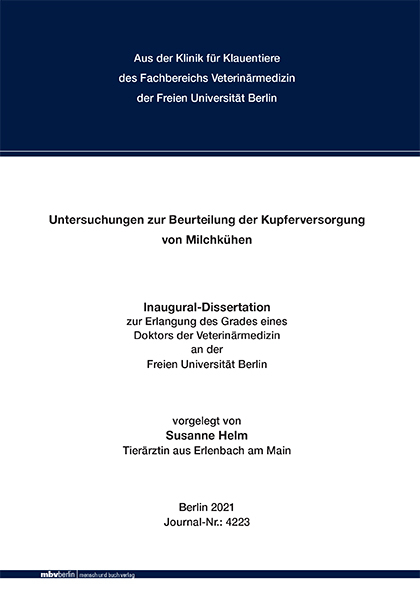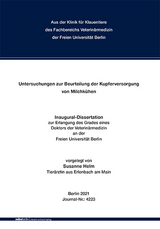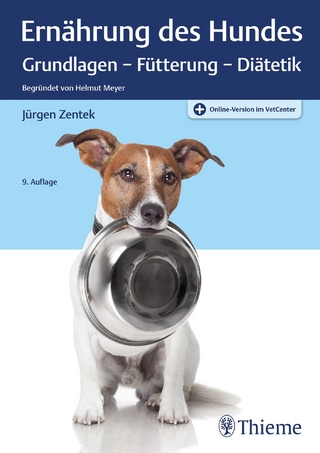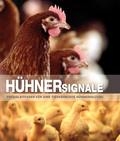Untersuchungen zur Beurteilung der Kupferversorgung von Milchkühen
Seiten
2021
|
1. Aufl.
Mensch & Buch (Verlag)
978-3-96729-099-8 (ISBN)
Mensch & Buch (Verlag)
978-3-96729-099-8 (ISBN)
- Keine Verlagsinformationen verfügbar
- Artikel merken
Das Spurenelement Kupfer spielt durch seine Beteiligung an zahlreichen physiologischen Prozessen eine essentielle Rolle im menschlichen und tierischen Organismus. Zur Erhaltung der Gesundheit und der Produktivität von Milchkühen ist daher eine adäquate Zufuhr von absorbierbarem Kupfer über das Futter unabdingbar. Aufgrund der besonderen Verdauungsphysiologie von Wiederkäuern stellt die optimale Futterzusammenstellung eine nicht zu unterschätzende Herausforderung dar. Gelingt die adäquate Kupferversorgung über die Nahrung nicht, kann es zu bedrohlichen Mangelerscheinungen oder Vergiftungen kommen, die nicht nur Einzeltiere, sondern auch die ganze Herde betreffen können. Um im Verdachtsfall schnell gegensteuern zu können, sind geeignete Diagnostika zur Erkennung der Versorgungslage und das Wissen um die Besonderheiten des Kupferstoffwechsels beim Rind von großer Bedeutung.
Im Fokus dieser Arbeit stand die Untersuchung der Kupferversorgung bei Milchkühen. Hierfür wurden Daten von 243 Milchviehbetrieben aus den östlichen Bundesländern ausgewertet, die zuvor im Rahmen der Bestandsbetreuung durch die Klinik für Klauentiere der FU-Berlin im Zeitraum von 2007 bis 2014 erhoben worden waren. Die Daten umfassten die Analyseergebnisse der Kupferkonzentration in Blut-, Haar-, Urin- und Kotproben von Kühen in verschiedenen Laktationsabschnitten. Die anschließende statistische Auswertung der Analyseergebnisse hatte zum Ziel, die Verteilung und das Verhalten des Spurenelements Kupfer in den einzelnen Probenmedien zu ermitteln, um daraus ihre jeweilige diagnostische Eignung zur Beurteilung des Kupferstatus bei Milchkühen abzuleiten und Referenzbereiche für eine physiologische Kupferkonzentration in den Probenmedien zu definieren. Zusätzlich wurden Zusammenhänge zwischen der Kupferkonzentration in den Probenmedien und anderen Parametern, wie den Serummesswerten anderer Mengen- und Spurenelemente, chemischen und hämatologischen Blutparametern sowie Produktions- und Fruchtbarkeitskennzahlen, untersucht. Um mögliche Einflüsse der (Jahres-)zeit, des geographischen Standorts sowie des Laktationsstadiums auf die Kupferkonzentration in den Probenmedien zu identifizieren, wurde zudem eine Varianzanalyse durchgeführt.
Aus den Ergebnissen der statistischen Auswertung lässt sich schließen, dass alle Probenmedien außer Urin die Versorgungslage des Organismus mit dem Spurenelement Kupfer widerspiegeln, sie zur Diagnose einer Unter- oder Überversorgung mit Kupfer jedoch nur eingeschränkt nutzbar sind. Der Kupfergehalt im Urin bewegt sich überwiegend im niedrigen Konzentrationsbereich. Deshalb wird eine diagnostische Eignung dieses Probenmediums, Versorgungsschwankungen zuverlässig anzuzeigen, bezweifelt. Unter den Blutprobenmedien nimmt die Kupferkonzentration im Plasma die höchsten Werte an, gefolgt von Vollblut und Serum, wobei letzteres die geringste Kupferkonzentration im Blut aufweist. Die Korrelationsanalyse zeigte, dass sich ein Anstieg der Kupferkonzentration im Blut am stärksten im Plasma niederschlägt. Deshalb wird die Konzentrationsanalyse des Plasmakupfers innerhalb der Blutprobenmedien als Diagnostikum der Wahl eingestuft. Das Probenmedium Haar spiegelt den Versorgungsstatus zeitverzögert wider. Es kann daher nicht verwendet werden, um kurzfristige Versorgungsschwankungen festzustellen, wohl aber, um sich einen Überblick über die Kupferversorgung der letzten Monate zu verschaffen. Fäkale Kupferkonzentrationen spiegeln eliminiertes und nicht aus der Nahrung absorbiertes Kupfer wider. Sie können beim Verdacht auf eine alimentäre Unter- oder Überversorgung zusätzliche Hinweise liefern.
Die Korrelationsanalysen zwischen der Kupferkonzentration in den einzelnen Probenmedien und hämatologischen sowie chemischen Blutparametern ergaben keine nennenswerten Zusammenhänge. Ähnlich verhielt es sich mit den Leistungs- und Produktionskennzahlen, die im Gegensatz zu den Erwartungen gar nicht oder nur äußerst schwach mit dem Kupferstatus korrelierten und deshalb zur Ableitung von Erkenntnissen nicht ausreichten. Um aussagekräftige Ergebnisse zu erhalten, müsste in einer Folgeuntersuchung das Versuchsdesign entsprechend geändert werden. Die signifikant positiven Korrelationen zwischen der Kupferkonzentration in den Blutprobenmedien und den Serummesswerten anderer Mengen- und Spurenelemente ließen auf eine gleichmäßige Zufuhr dieser Nährstoffe schließen und unterstützten die Annahme einer bedarfsgerechten Versorgung der Probanden. Die Varianzanalyse zeigte deutlich, dass der Kupferstatus von Milchkühen (jahres-)zeitlichen und geographischen Einflüssen unterliegt. So verzeichneten Kühe im vierten Quartal des Jahres die höchsten mittleren Plasmakupferkonzentrationen. Dies kann als Hinweis dafür verstanden werden, dass bei herbstlichen Temperaturen der Kuhkomfort und damit auch die Futter- und Spurenelementaufnahme steigen. Kühe aus Thüringen wiesen im Vergleich der Bundesländer den niedrigsten Kupferstatus im Plasma auf. Dies kann an niedrigeren Kupferkonzentrationen im Grundfutter oder der TMR liegen. Es kann aber auch damit zusammenhängen, dass in den übrigen Bundesländern vergleichsweise mehr Kupfer über Mineralergänzungsfutter supplementiert wird. Den Einfluss des Laktationsstadiums auf die Kupferkonzentration betreffend, lässt sich zusammenfassend feststellen, dass frischmelkende Kühe unmittelbar nach der Kalbung in allen drei Blutprobenmedien die höchste Kupferkonzentration aufwiesen. Während der Früh- und der Hochlaktation sank die Kupferkonzentration, um bei Kühen in der Vorbereiterphase den niedrigsten Wert anzunehmen. Diese wellenförmige Dynamik der Kupferkonzentration im Blut sollte in Form von getrennten Referenzbereichen für Vorbereiter, Früh- und Hochlaktationskühe auch in der Routinediagnostik berücksichtigt werden. Im Haar war die Laktationsdynamik zeitlich verschoben. Die höchste Kupferkonzentration fand sich im Haar von Hochlaktationskühen. Examinations of copper supply in dairy cows
The trace element copper plays an essential role in numerous physiological processes in human and animal organisms. Therefore, the adequate supply of absorbable copper is vital to meet the nutritional requirements of dairy cows und to support their health and productivity. Due to the special digestive physiology of ruminants choosing the optimal feed composition can be challenging. When feedstuff fails to provide an appropriate copper supply, single animals or even entire herds can be affected by severe deficiencies or intoxications. In order to identify and treat nutritional disorders in cases of clinical suspicion, valid and applicable diagnostic methods to reveal the copper supply in dairy cows are as important as the knowledge about the special features of copper metabolism in cattle in general.
This study focuses on the examination of copper supply in dairy cows. Therefore, data from 243 dairy farms located in several eastern federal states of Germany were collected by Free University of Berlin´s Ruminant and Swine Clinic between 2007 and 2014. Sample materials were blood plasma, blood serum, whole blood, urine, feces and hair of clinically healthy, multiparous dairy cows in different stages of lactation. The copper content in all sample materials was determined and statistically analyzed. This statistical evaluation aimed first of all at detecting the distribution of copper in the different sample materials and at determining their usability in diagnostic investigation of copper supply in dairy cows. Reference values for physiological copper concentrations were calculated for each sample material. In addition to that, correlations between copper content of all sample materials and other parameters like serum concentrations of other trace and major elements, blood chemistry and hematology values as well as parameters of reproductive performance and productivity of the dairy herd were determined. Finally, the influence of different stages of lactation as well as geographic and seasonal influences on copper concentration in each sample material were examined by variance analysis.
Results suggest that apart from urine all sample materials reflect the copper supply of dairy cows, even though their diagnostic usability is limited. The copper concentration found in urine remains constantly low and does not seem appropriate to indicate deviations from an optimal copper supply of the organism. Among the different blood samples the highest copper content was found in plasma, followed by whole blood and serum. The latter showed the lowest copper concentration of all blood sample media. Results of the correlation analysis suggest that plasma is the most sensitive blood medium to demonstrate an increasing copper supply. Therefore, it is considered as the medium of choice to measure the copper concentration in blood.
The copper content in hair samples was found to reflect the supply of the organism in a temporally delayed manner. It cannot be used to detect short-term deviations, but gives an idea of the course of copper supply during the past few months. The copper content of feces is composed of copper eliminated by biliary excretion and of copper, which has not been absorbed from ingesta. In suspicious cases it can be used to indicate an alimentary under- or oversupply.
There were no important correlations found between the copper concentration of the sample media and other parameters like hematology or chemistry values. Contrary to expectations, characteristics of reproductive performance and productivity showed, if at all, weak correlations to copper concentrations measured in the different sample materials. Results could not be used to draw any conclusions from. Further research within another specifically designed study is required to obtain more detailed findings. Significantly positive correlations found between copper concentrations of blood samples and serum concentrations of other trace or major elements suggest consistent intakes of these nutrients and support the assumption of an adequate supply of the animals.
Variance analysis showed clearly that the copper supply of dairy cows is influenced by geographic and seasonal circumstances. Average values of plasma copper were found to be the highest between October and December, which can be seen as indication that lower temperatures in autumn improve cow comfort and hereby further a simultaneous increase of food and trace element intake. Dairy cows from Thuringia showed the lowest copper concentration in plasma compared to animals in other eastern federal states. These findings might be the consequence of lower copper concentrations in forage plants and total mixed rations in Thuringia or could indicate higher levels of copper supplementation in the other states.
The evaluation of the impact of different stages of lactation on copper status led to the conclusion that cows showed the highest blood copper concentration in the first week after calving, followed by a decrease during early and mid lactation. The lowest blood copper concentrations were found in transition cows three weeks before calving. In routine diagnostics, these wavelike dynamics of copper concentration in blood should be considered in terms of separate reference ranges for transition cows, early lactation and mid lactation cows. In hair samples the influence of dynamics of lactation on copper concentration was temporally delayed. Hair samples of mid lactation cows showed the highest levels of copper concentration.
Im Fokus dieser Arbeit stand die Untersuchung der Kupferversorgung bei Milchkühen. Hierfür wurden Daten von 243 Milchviehbetrieben aus den östlichen Bundesländern ausgewertet, die zuvor im Rahmen der Bestandsbetreuung durch die Klinik für Klauentiere der FU-Berlin im Zeitraum von 2007 bis 2014 erhoben worden waren. Die Daten umfassten die Analyseergebnisse der Kupferkonzentration in Blut-, Haar-, Urin- und Kotproben von Kühen in verschiedenen Laktationsabschnitten. Die anschließende statistische Auswertung der Analyseergebnisse hatte zum Ziel, die Verteilung und das Verhalten des Spurenelements Kupfer in den einzelnen Probenmedien zu ermitteln, um daraus ihre jeweilige diagnostische Eignung zur Beurteilung des Kupferstatus bei Milchkühen abzuleiten und Referenzbereiche für eine physiologische Kupferkonzentration in den Probenmedien zu definieren. Zusätzlich wurden Zusammenhänge zwischen der Kupferkonzentration in den Probenmedien und anderen Parametern, wie den Serummesswerten anderer Mengen- und Spurenelemente, chemischen und hämatologischen Blutparametern sowie Produktions- und Fruchtbarkeitskennzahlen, untersucht. Um mögliche Einflüsse der (Jahres-)zeit, des geographischen Standorts sowie des Laktationsstadiums auf die Kupferkonzentration in den Probenmedien zu identifizieren, wurde zudem eine Varianzanalyse durchgeführt.
Aus den Ergebnissen der statistischen Auswertung lässt sich schließen, dass alle Probenmedien außer Urin die Versorgungslage des Organismus mit dem Spurenelement Kupfer widerspiegeln, sie zur Diagnose einer Unter- oder Überversorgung mit Kupfer jedoch nur eingeschränkt nutzbar sind. Der Kupfergehalt im Urin bewegt sich überwiegend im niedrigen Konzentrationsbereich. Deshalb wird eine diagnostische Eignung dieses Probenmediums, Versorgungsschwankungen zuverlässig anzuzeigen, bezweifelt. Unter den Blutprobenmedien nimmt die Kupferkonzentration im Plasma die höchsten Werte an, gefolgt von Vollblut und Serum, wobei letzteres die geringste Kupferkonzentration im Blut aufweist. Die Korrelationsanalyse zeigte, dass sich ein Anstieg der Kupferkonzentration im Blut am stärksten im Plasma niederschlägt. Deshalb wird die Konzentrationsanalyse des Plasmakupfers innerhalb der Blutprobenmedien als Diagnostikum der Wahl eingestuft. Das Probenmedium Haar spiegelt den Versorgungsstatus zeitverzögert wider. Es kann daher nicht verwendet werden, um kurzfristige Versorgungsschwankungen festzustellen, wohl aber, um sich einen Überblick über die Kupferversorgung der letzten Monate zu verschaffen. Fäkale Kupferkonzentrationen spiegeln eliminiertes und nicht aus der Nahrung absorbiertes Kupfer wider. Sie können beim Verdacht auf eine alimentäre Unter- oder Überversorgung zusätzliche Hinweise liefern.
Die Korrelationsanalysen zwischen der Kupferkonzentration in den einzelnen Probenmedien und hämatologischen sowie chemischen Blutparametern ergaben keine nennenswerten Zusammenhänge. Ähnlich verhielt es sich mit den Leistungs- und Produktionskennzahlen, die im Gegensatz zu den Erwartungen gar nicht oder nur äußerst schwach mit dem Kupferstatus korrelierten und deshalb zur Ableitung von Erkenntnissen nicht ausreichten. Um aussagekräftige Ergebnisse zu erhalten, müsste in einer Folgeuntersuchung das Versuchsdesign entsprechend geändert werden. Die signifikant positiven Korrelationen zwischen der Kupferkonzentration in den Blutprobenmedien und den Serummesswerten anderer Mengen- und Spurenelemente ließen auf eine gleichmäßige Zufuhr dieser Nährstoffe schließen und unterstützten die Annahme einer bedarfsgerechten Versorgung der Probanden. Die Varianzanalyse zeigte deutlich, dass der Kupferstatus von Milchkühen (jahres-)zeitlichen und geographischen Einflüssen unterliegt. So verzeichneten Kühe im vierten Quartal des Jahres die höchsten mittleren Plasmakupferkonzentrationen. Dies kann als Hinweis dafür verstanden werden, dass bei herbstlichen Temperaturen der Kuhkomfort und damit auch die Futter- und Spurenelementaufnahme steigen. Kühe aus Thüringen wiesen im Vergleich der Bundesländer den niedrigsten Kupferstatus im Plasma auf. Dies kann an niedrigeren Kupferkonzentrationen im Grundfutter oder der TMR liegen. Es kann aber auch damit zusammenhängen, dass in den übrigen Bundesländern vergleichsweise mehr Kupfer über Mineralergänzungsfutter supplementiert wird. Den Einfluss des Laktationsstadiums auf die Kupferkonzentration betreffend, lässt sich zusammenfassend feststellen, dass frischmelkende Kühe unmittelbar nach der Kalbung in allen drei Blutprobenmedien die höchste Kupferkonzentration aufwiesen. Während der Früh- und der Hochlaktation sank die Kupferkonzentration, um bei Kühen in der Vorbereiterphase den niedrigsten Wert anzunehmen. Diese wellenförmige Dynamik der Kupferkonzentration im Blut sollte in Form von getrennten Referenzbereichen für Vorbereiter, Früh- und Hochlaktationskühe auch in der Routinediagnostik berücksichtigt werden. Im Haar war die Laktationsdynamik zeitlich verschoben. Die höchste Kupferkonzentration fand sich im Haar von Hochlaktationskühen. Examinations of copper supply in dairy cows
The trace element copper plays an essential role in numerous physiological processes in human and animal organisms. Therefore, the adequate supply of absorbable copper is vital to meet the nutritional requirements of dairy cows und to support their health and productivity. Due to the special digestive physiology of ruminants choosing the optimal feed composition can be challenging. When feedstuff fails to provide an appropriate copper supply, single animals or even entire herds can be affected by severe deficiencies or intoxications. In order to identify and treat nutritional disorders in cases of clinical suspicion, valid and applicable diagnostic methods to reveal the copper supply in dairy cows are as important as the knowledge about the special features of copper metabolism in cattle in general.
This study focuses on the examination of copper supply in dairy cows. Therefore, data from 243 dairy farms located in several eastern federal states of Germany were collected by Free University of Berlin´s Ruminant and Swine Clinic between 2007 and 2014. Sample materials were blood plasma, blood serum, whole blood, urine, feces and hair of clinically healthy, multiparous dairy cows in different stages of lactation. The copper content in all sample materials was determined and statistically analyzed. This statistical evaluation aimed first of all at detecting the distribution of copper in the different sample materials and at determining their usability in diagnostic investigation of copper supply in dairy cows. Reference values for physiological copper concentrations were calculated for each sample material. In addition to that, correlations between copper content of all sample materials and other parameters like serum concentrations of other trace and major elements, blood chemistry and hematology values as well as parameters of reproductive performance and productivity of the dairy herd were determined. Finally, the influence of different stages of lactation as well as geographic and seasonal influences on copper concentration in each sample material were examined by variance analysis.
Results suggest that apart from urine all sample materials reflect the copper supply of dairy cows, even though their diagnostic usability is limited. The copper concentration found in urine remains constantly low and does not seem appropriate to indicate deviations from an optimal copper supply of the organism. Among the different blood samples the highest copper content was found in plasma, followed by whole blood and serum. The latter showed the lowest copper concentration of all blood sample media. Results of the correlation analysis suggest that plasma is the most sensitive blood medium to demonstrate an increasing copper supply. Therefore, it is considered as the medium of choice to measure the copper concentration in blood.
The copper content in hair samples was found to reflect the supply of the organism in a temporally delayed manner. It cannot be used to detect short-term deviations, but gives an idea of the course of copper supply during the past few months. The copper content of feces is composed of copper eliminated by biliary excretion and of copper, which has not been absorbed from ingesta. In suspicious cases it can be used to indicate an alimentary under- or oversupply.
There were no important correlations found between the copper concentration of the sample media and other parameters like hematology or chemistry values. Contrary to expectations, characteristics of reproductive performance and productivity showed, if at all, weak correlations to copper concentrations measured in the different sample materials. Results could not be used to draw any conclusions from. Further research within another specifically designed study is required to obtain more detailed findings. Significantly positive correlations found between copper concentrations of blood samples and serum concentrations of other trace or major elements suggest consistent intakes of these nutrients and support the assumption of an adequate supply of the animals.
Variance analysis showed clearly that the copper supply of dairy cows is influenced by geographic and seasonal circumstances. Average values of plasma copper were found to be the highest between October and December, which can be seen as indication that lower temperatures in autumn improve cow comfort and hereby further a simultaneous increase of food and trace element intake. Dairy cows from Thuringia showed the lowest copper concentration in plasma compared to animals in other eastern federal states. These findings might be the consequence of lower copper concentrations in forage plants and total mixed rations in Thuringia or could indicate higher levels of copper supplementation in the other states.
The evaluation of the impact of different stages of lactation on copper status led to the conclusion that cows showed the highest blood copper concentration in the first week after calving, followed by a decrease during early and mid lactation. The lowest blood copper concentrations were found in transition cows three weeks before calving. In routine diagnostics, these wavelike dynamics of copper concentration in blood should be considered in terms of separate reference ranges for transition cows, early lactation and mid lactation cows. In hair samples the influence of dynamics of lactation on copper concentration was temporally delayed. Hair samples of mid lactation cows showed the highest levels of copper concentration.
| Erscheinungsdatum | 19.04.2021 |
|---|---|
| Verlagsort | Berlin |
| Sprache | deutsch |
| Maße | 148 x 210 mm |
| Themenwelt | Veterinärmedizin ► Allgemein ► Tierernährung / Tierhaltung / Tierzucht |
| Veterinärmedizin ► Großtier | |
| Schlagworte | Animal nutrition • Blood • Blut • Copper • dairy cows • Faces • Fäkalien • Feeding • Fütterung • Haare • Hair • Kupfer • Milchkühe • Mineral Nutrition • Mineralstoffversorgung • Spectrometry • Spektrometrie • Tierernährung • Urin • Urine |
| ISBN-10 | 3-96729-099-9 / 3967290999 |
| ISBN-13 | 978-3-96729-099-8 / 9783967290998 |
| Zustand | Neuware |
| Haben Sie eine Frage zum Produkt? |
Mehr entdecken
aus dem Bereich
aus dem Bereich
Grundlagen - Fütterung - Diätetik Begründet von Helmut Meyer
Buch (2022)
Thieme (Verlag)
91,00 €
Praxisleitfaden für eine tiergerechte Hühnerhaltung
Buch | Softcover (2023)
Landwirtschaftsverlag Münster
44,80 €




